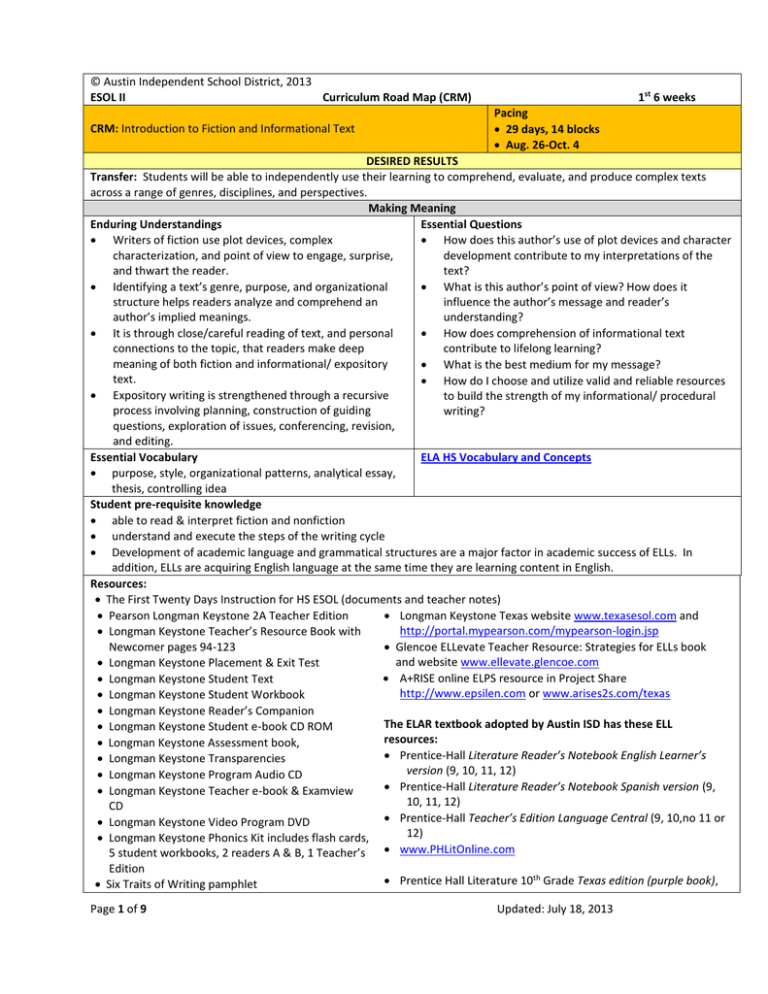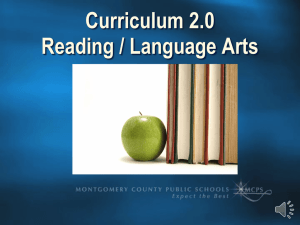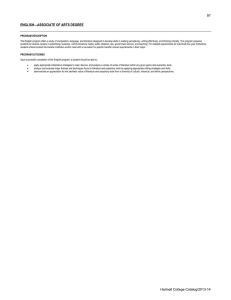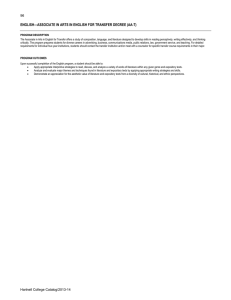
© Austin Independent School District, 2013
ESOL II
Curriculum Road Map (CRM)
CRM: Introduction to Fiction and Informational Text
1st 6 weeks
Pacing
29 days, 14 blocks
Aug. 26-Oct. 4
DESIRED RESULTS
Transfer: Students will be able to independently use their learning to comprehend, evaluate, and produce complex texts
across a range of genres, disciplines, and perspectives.
Making Meaning
Enduring Understandings
Essential Questions
Writers of fiction use plot devices, complex
How does this author’s use of plot devices and character
characterization, and point of view to engage, surprise,
development contribute to my interpretations of the
and thwart the reader.
text?
Identifying a text’s genre, purpose, and organizational
What is this author’s point of view? How does it
structure helps readers analyze and comprehend an
influence the author’s message and reader’s
author’s implied meanings.
understanding?
It is through close/careful reading of text, and personal
How does comprehension of informational text
connections to the topic, that readers make deep
contribute to lifelong learning?
meaning of both fiction and informational/ expository
What is the best medium for my message?
text.
How do I choose and utilize valid and reliable resources
Expository writing is strengthened through a recursive
to build the strength of my informational/ procedural
process involving planning, construction of guiding
writing?
questions, exploration of issues, conferencing, revision,
and editing.
Essential Vocabulary
ELA HS Vocabulary and Concepts
purpose, style, organizational patterns, analytical essay,
thesis, controlling idea
Student pre-requisite knowledge
able to read & interpret fiction and nonfiction
understand and execute the steps of the writing cycle
Development of academic language and grammatical structures are a major factor in academic success of ELLs. In
addition, ELLs are acquiring English language at the same time they are learning content in English.
Resources:
The First Twenty Days Instruction for HS ESOL (documents and teacher notes)
Pearson Longman Keystone 2A Teacher Edition
Longman Keystone Texas website www.texasesol.com and
http://portal.mypearson.com/mypearson-login.jsp
Longman Keystone Teacher’s Resource Book with
Newcomer pages 94-123
Glencoe ELLevate Teacher Resource: Strategies for ELLs book
and website www.ellevate.glencoe.com
Longman Keystone Placement & Exit Test
A+RISE online ELPS resource in Project Share
Longman Keystone Student Text
http://www.epsilen.com or www.arises2s.com/texas
Longman Keystone Student Workbook
Longman Keystone Reader’s Companion
The ELAR textbook adopted by Austin ISD has these ELL
Longman Keystone Student e-book CD ROM
resources:
Longman Keystone Assessment book,
Prentice-Hall Literature Reader’s Notebook English Learner’s
Longman Keystone Transparencies
version (9, 10, 11, 12)
Longman Keystone Program Audio CD
Prentice-Hall
Literature Reader’s Notebook Spanish version (9,
Longman Keystone Teacher e-book & Examview
10,
11,
12)
CD
Prentice-Hall Teacher’s Edition Language Central (9, 10,no 11 or
Longman Keystone Video Program DVD
12)
Longman Keystone Phonics Kit includes flash cards,
5 student workbooks, 2 readers A & B, 1 Teacher’s www.PHLitOnline.com
Edition
Six Traits of Writing pamphlet
Page 1 of 9
Prentice Hall Literature 10th Grade Texas edition (purple book),
Updated: July 18, 2013
Penguin Readers-18 readers
Online Success tracker and essay scorer
www.pearsonsuccessnet.com
(Selections by Grade, Genre, and Lexile, English II Writing
Resources, and teacher-selected fiction and informational
texts
ELA curriculum documents and resources
Pre-AP and AP: Advanced Placement Vertical Teams Guide and Pre-AP Resource Bank:
http://curriculum.austinisd.org/adv_ac/preAP/curriculum.html
ELPS: Mandated by Texas Administrative Code (19 TAC §74.4), click on the link for English Language Proficiency Standards
(ELPS) to support English Language Learners.
ARC #1: Getting Started/Routines and Procedures
Arc Pacing: 9 Days (5 Blocks)
Purpose of Fiction
Targeted Vocabulary: external/internal conflict, exposition, rising action, climax, falling action, resolution, linear plot
development, non-linear plot development, theme, moral dilemma
Resources: Pearson Longman Keystone ESOL Textbook, Prentice Hall Literature Textbook, 10th Grade (Selections by Grade,
Genre, and Lexile, English II Writing Resources, and teacher-selected fiction and informational texts
TEKS Knowledge & Skills
Acquisition
STAAR: RC = Reporting Category; DC = Dual
Students Will Know
Students Will Be Able To
Coded Skills; Readiness Standard; Supporting
Standard Concepts are addressed in another
unit.
E2.2 Reading/Comprehension of Literary Text/Theme and Genre. Students analyze, make inferences and draw conclusions
about theme and genre in different cultural, historical, and contemporary contexts and provide evidence from the text to
support their understanding.
E2.2A compare and contrast differences in
Experiences are universal
Identify archetypes in literature.
similar themes expressed in different time
and are portrayed in
Identify attributes of mythic,
periods RC1
various manners in
classical, and traditional literature
different
time
periods
in 20th and 21st century literature.
E2.2B analyze archetypes (e.g., journey of a
through
theme.
Describe the effect of the
hero, tragic flaw) in mythic, traditional and
Archetypes such as hero’s
attributes on contemporary
classical literature RC2
journey.
literature.
E2.2C relate the figurative language of a
Attributes
of
mythical,
Analyze theme in a group setting
literary work to its historical and cultural
traditional,
and
classical
and individually.
setting RC2
literature.
Identify figurative language.
Authors take inspiration
Explain how figurative language
from older texts and use
portrays historical and cultural
their attributes to breathe
setting.
life into their own texts.
Figurative language is
shaped by culture and time
period.
E2.5 Reading/Comprehension of Literary Text/Fiction. Students understand, make inferences and draw conclusions about
the structure and elements of fiction and provide evidence from text to support their understanding.
E2.5A analyze isolated scenes and their
contribution to the success of the plot as a
whole in a variety of works of fiction RC2
E2.5B analyze differences in the characters'
moral dilemmas in works of fiction across
different countries or cultures RC2
E2.5C evaluate the connection between forms
of narration (e.g., unreliable, omniscient) and
tone in works of fiction RC2
Page 2 of 9
Advanced plot structures
(flashbacks, parallel plot).
Characterization strategies
and how authors portray
moral dilemmas.
Point of view and how it
affects tone.
Writing strategies fictional
writers use for their genre.
Identify the importance of
individual scenes and incorporate
plot structures into their own
writing.
Appreciate complex
characterization and moral
dilemmas and incorporate both in
their own fictional writing.
Understand the nuance of different
Updated: July 18, 2013
E2.5D demonstrate familiarity with works by
authors from non-English-speaking literary
traditions with emphasis on 20th century world
literature
Writing strategies that
overlap between fiction
and other genres.
E2.7A explain the function of symbolism,
allegory, and allusions in literary works RC2
Authors often use double
meanings.
Irony is a contradiction
between appearance and
reality.
Mature readers read a text
on two levels – literal and
symbolic.
points of view and use point of
view as means to affect tone in
their own fictional writing.
Contribute to making meaning of a
fictional text in a literature circle.
E2.7 Reading/Comprehension of Literary Text/Sensory Language. Students understand, make inferences and draw conclusions
about how an author's sensory language creates imagery in literary text and provide evidence from text to support their
understanding.
Locate places in text when authors
use irony, sarcasm and/or paradox.
Explain the effect that irony,
sarcasm and/or paradox have on
the meaning of a text.
Use irony, sarcasm, and paradox to
improve their writing.
E2.15 Writing/Expository and Procedural Texts. Students write expository and procedural or work-related texts to
communicate ideas and information to specific audiences for specific purposes.
E2.15A write an analytical essay of sufficient
length that includes: RC4
E2.15Aiii a thesis or controlling idea RC4, RC5
E2.15Aiv an organizing structure appropriate to
purpose, audience, and context RC4, RC5
ARC # 2: Purpose of Informational Text
Thesis statements focus
the writing.
The more focused the
writing, the more likely the
reader will be informed
and engaged by the text.
Organization not only
clarifies meaning, it also
serves to emphasize
meaning.
Craft a focused and meaningful
thesis.
Decide upon and implement an
organizing structure that serves a
writer's message.
Select evidence that best supports
their message.
Arc Pacing: 10 Days (5 Blocks)
Targeted Vocabulary: purpose, literary nonfiction, expository, informational text, tone, connotation, denotation, style,
organizational patterns
Resources: Pearson Longman Keystone ESOL Textbook, Prentice Hall Literature Textbook, 10th Grade (Selections by Grade,
Genre, and Lexile, English II Writing Resources, and teacher-selected fiction and informational texts
TEKS Knowledge & Skills
Acquisition
STAAR: RC = Reporting Category; DC = Dual
Students Will Know
Students Will Be Able To
Coded Skills; Readiness Standard; Supporting
Standard Concepts are addressed in another
unit.
E2.8 Reading/Comprehension of Informational Text/Culture and History. Students analyze, make inferences and draw
conclusions about the author's purpose in cultural, historical, and contemporary contexts and provide evidence from the text
to support their understanding.
E2.8A analyze the controlling idea and specific
purpose of a passage and the textual elements
that support and elaborate it, including both
the most important details and the less
important details RC3
Page 3 of 9
Authors write for specific
purposes to specific
audiences.
The central idea of a work
is created by details and
some of the details are
more important than
others.
Analyze and evaluate the central
message of an expository text and
make unique connections to
relevant text.
Evaluate the author’s purpose and
make unique personal and literary
connections.
Analyze the structure of the text
Updated: July 18, 2013
and the relevance of both
important and unimportant details.
Choose relevant, specific and
meaningful textual evidence to
support his or her analysis.
E2.9 Reading/Comprehension of Informational Text/Expository Text. Students analyze, make inferences and draw conclusions
about expository text and provide evidence from text to support their understanding.
E2.9A summarize text and distinguish between
a summary and a critique and identify nonessential information in a summary and
unsubstantiated opinions in a critique RC3
E2.9B distinguish among different kinds of
evidence (e.g., logical, empirical, anecdotal)
used to support conclusions and arguments in
texts RC3
E2.9C make and defend subtle inferences and
complex conclusions about the ideas in text and
their organizational patterns RC3
E2.9D synthesize and make logical connections
between ideas and details in several texts
selected to reflect a range of viewpoints on the
same topic and support those findings with
textual evidence RC1
An author can write an
expository text from either
a neutral or a critical
position.
Authors may include nonessential information or
unsubstantiated opinions,
which affects the efficacy
of their writing.
Mature readers use their
knowledge of evidence and
rhetorical devices to
critically interpret an
author’s message.
Mature readers connect
ideas across different parts
of the text and understand
that organizational
patterns help create
meaning.
Mature readers process
ideas from different texts.
Identify whether a person is writing
from an objective or biased
position.
Evaluate the efficacy of text by
paying attention to non-essential
information and unsubstantiated
opinions.
Evaluate the quality of evidence
and rhetorical strategies and their
effect on the text.
Read across several texts and
synthesize ideas, supporting with
textual evidence.
Contribute to making meaning of
expository texts in informational
text centers.
E2.10 Reading/Comprehension of Informational Text/Persuasive Text. Students analyze, make inferences and draw conclusions
about persuasive text and provide evidence from text to support their analysis.
E2.10A explain shifts in perspective in
arguments about the same topic and evaluate
the accuracy of the evidence used to support
the different viewpoints within those
arguments RC3
Shifts in argument often
signal important meaning
in persuasive texts.
Evidence is not always
reliable, and mature
readers evaluate the
accuracy before agreeing
with or believing and
argument.
Logical fallacies are used
widely, but signal a weak
argument.
Mature readers recognize
fallacies and evaluate
arguments.
E2.15A write an analytical essay of sufficient
length that includes RC4
Analytical and expository
writing explains and
Identify and analyze shifts in
argument to make complex
inferences.
Read and evaluate the quality of
evidence presented in an
argument.
E2.10B analyze contemporary political debates
Break apart and analyze rhetorical
for such rhetorical and logical fallacies as
structures and craft and evaluate
appeals to commonly held opinions, false
their efficacy in promoting an
dilemmas, appeals to pity, and personal attacks
author's argument.
Identify logical fallacies in
arguments and evaluate arguments
accordingly.
Contribute to making meaning of
persuasive texts in informational
text centers.
E2.15 Writing/Expository and Procedural Texts. Students write expository and procedural or work-related texts to
communicate ideas and information to specific audiences for specific purposes.
Page 4 of 9
Write an expository essay that
explains an issue.
Updated: July 18, 2013
E2.15Ai effective introductory and concluding
paragraphs and a variety of sentence structures
RC4, RC5
E2.15Aii rhetorical devices, and transitions
between paragraphs RC4, RC5
E2.15Aiii a thesis or controlling idea RC4, RC5
E2.15Aiv an organizing structure appropriate to
purpose, audience, and context RC4, RC5
E2.15Av relevant evidence and well-chosen
details RC4, RC5
E2.15Avi distinctions about the relative value of
specific data, facts, and ideas that support the
thesis statement RC4, RC5
describes an issue.
Introductions and
conclusions draw the
reader in and leave the
text feeling complete.
Writer's strategies like
rhetorical devices and
transitions help the
readers appreciate the
writer's message.
Thesis statements focus
the writing.
The more focused the
writing, the more likely the
reader will be informed
and engaged by the text.
Organization not only
clarifies meaning, it also
serves to emphasize
meaning.
The quality of a writer's
evidence will affect the
efficacy of his or her
message.
Mature writers honestly
assess the evidence used
to support a thesis.
ARC #3: Comparing Short Fiction and Short Informational Text
Write introductions and
conclusions that serve the message
of the writing.
Use rhetorical devices and
transitions which bolster writer's
message.
Craft a focused and meaningful
thesis.
Decide upon and implement an
organizing structure that serves a
writer's message.
Select evidence that best supports
their message.
Honestly assess the evidence used
to support a thesis.
Arc Pacing: 10 Days (5 Blocks)
Targeted Vocabulary: purpose, literary nonfiction, expository, informational text, tone, connotation, denotation, style,
organizational patterns, style, shift
Resources: Pearson Longman Keystone ESOL Textbook, Prentice Hall Literature Textbook, 10th Grade (Selections by Grade,
Genre, and Lexile, English II Writing Resources, and teacher-selected fiction and informational texts
TEKS Knowledge & Skills
Acquisition
STAAR: RC = Reporting Category; DC = Dual
Students Will Know
Students Will Be Able To
Coded Skills; Readiness Standard; Supporting
Standard Concepts are addressed in another
unit.
E2.5 Reading/Comprehension of Literary Text/Fiction. Students understand, make inferences and draw conclusions about the
structure and elements of fiction and provide evidence from text to support their understanding.
E2.5A analyze isolated scenes and their
contribution to the success of the plot as a
whole in a variety of works of fiction RC2
E2.5B analyze differences in the characters'
moral dilemmas in works of fiction across
different countries or cultures RC2
E2.5C evaluate the connection between forms
of narration (e.g., unreliable, omniscient) and
tone in works of fiction RC2
E2.5D demonstrate familiarity with works by
authors from non-English-speaking literary
Page 5 of 9
Advanced plot structures
(flashbacks, parallel plot).
Characterization strategies
and how authors portray
moral dilemmas.
Point of view and how it
affects tone.
Writing strategies fictional
writers use for their genre.
Writing strategies that
overlap between fiction
Identify the importance of
individual scenes and incorporate
plot structures into their own
writing.
Appreciate complex
characterization and moral
dilemmas and incorporate both in
their own fictional writing.
Understand the nuance of different
points of view and use point of
view as means to affect tone in
their own fictional writing.
Updated: July 18, 2013
traditions with emphasis on 20th century world
literature
and other genres.
Contribute to making meaning of a
fictional text in a literature circle.
E2.9 Reading/Comprehension of Informational Text/Expository Text. Students analyze, make inferences and draw conclusions
about expository text and provide evidence from text to support their understanding.
E2.9A summarize text and distinguish between
a summary and a critique and identify nonessential information in a summary and
unsubstantiated opinions in a critique RC3
E2.9B distinguish among different kinds of
evidence (e.g., logical, empirical, anecdotal)
used to support conclusions and arguments in
texts RC3
E2.9C make and defend subtle inferences and
complex conclusions about the ideas in text and
their organizational patterns RC3
E2.9D synthesize and make logical connections
between ideas and details in several texts
selected to reflect a range of viewpoints on the
same topic and support those findings with
textual evidence RC1
An author can write an
expository text from either
a neutral or a critical
position.
Authors may include nonessential information or
unsubstantiated opinions,
which affects the efficacy
of their writing.
Mature readers use their
knowledge of evidence and
rhetorical devices to
critically interpret an
author’s message.
Mature readers connect
ideas across different parts
of the text and understand
that organizational
patterns help create
meaning.
Mature readers process
ideas from different texts.
Identify whether a person is writing
from an objective or biased
position.
Evaluate the efficacy of text by
paying attention to non-essential
information and unsubstantiated
opinions.
Evaluate the quality of evidence
and rhetorical strategies and their
effect on the impact of text.
Read across several texts and
synthesize ideas, supporting with
textual evidence.
Contribute to making meaning of
expository texts.
E2.15 Writing/Expository and Procedural Texts. Students write expository and procedural or work-related texts to
communicate ideas and information to specific audiences for specific purposes.
E2.15A write an analytical essay of sufficient
length that includes RC4
E2.15Ai effective introductory and concluding
paragraphs and a variety of sentence structures
RC4, RC5
E2.15Aii rhetorical devices, and transitions
between paragraphs RC4, RC5
E2.15Aiii a thesis or controlling idea RC4, RC5
E2.15Aiv an organizing structure appropriate to
purpose, audience, and context RC4, RC5
E2.15Av relevant evidence and well-chosen
details RC4, RC5
E2.15Avi distinctions about the relative value of
specific data, facts, and ideas that support the
thesis statement RC4, RC5
Page 6 of 9
Analytical and expository
writing explains and
describes an issue.
Introductions and
conclusions draw the
reader in and leave the
text feeling complete.
Writer's strategies like
rhetorical devices and
transitions help readers
appreciate the writer's
message.
Thesis statements focus
the writing.
The more focused the
writing, the more likely the
reader will be informed
and engaged by the text.
Organization not only
clarifies meaning, it also
serves to emphasize
meaning.
The quality of a writer's
Write an expository essay that
explains an issue.
Write introductions and
conclusions that serve the message
of the writing.
Use rhetorical devices and
transitions which bolster writer's
message.
Craft a focused and meaningful
thesis.
Decide upon and implement an
organizing structure that serves a
writer's message.
Select evidence that best supports
their message.
Honestly assess the evidence used
to support a thesis.
Updated: July 18, 2013
Page 7 of 9
evidence will affect the
efficacy of his or her
message.
Mature writers honestly
assess the evidence used
to support a thesis.
Updated: July 18, 2013
ASSESSMENT EVIDENCE
Student Work Products/Assessment Evidence
TEA mandate requires the use of linguistic accommodations for the ELLs, as determined by the LPAC.
Accommodations are available online from LPAS (Language Proficiency Assessment System).
Refer to http://www.tea.state.tx.us/student.assessment/accommodations
Performance Assessment
Other Evidence (i.e. unit tests, open ended exams, quiz,
essay, student work samples, observations, etc.)
The assessments below are suggested. Choose from the
list, based on ELL proficiency level and your pacing.
Change a linear plot for class to a non-linear plot by
adding a flashback, flash-forward, or changing the
beginning so that it starts in the middle (in medias
res). Or create a 6- to 8-box cartoon strip to illustrate
the main elements of the short story.
Complete a graphic organizer that continually
questions the author:
o
“List Detail” (“The door was painted green,
the color of hope.”)
o
“Question the Author” (Why might a writer
describe a door as have the color of
emotion?)
o
“Inference” (The door stands for opportunity)
Complete a running list of details that portray conflict
for characters, internally or externally, through several
stories. Students compare how authors portray
conflict in Short Answer Response format
Complete graphic organizers chronicling author’s use
of descriptions of actions, thoughts, and feelings to
characterize their characters. Students should explain
how characterization details move the plot or portray
theme in Short Answer Response format
Analyze text features in informational text: list text
feature and make inferences about Author’s Purpose
Analyze voice in informational text—list word choice,
attitude, and sentence structure. Students write
analysis of Voice in Short Answer Format
Complete graphic organizer for informational text
which lists: “Details from Text,” “What They Mean,”
and “Controlling Idea”
Page 8 of 9
Short Cycle Assessment
Testing Window: Sep. 30- Oct. 8
1A, 1B, 2, 2A, 8A
Fiction: F19B, 5, 5A, 5B, 5C
Expository: F19B, 9, 9A, 9C, 9D
Additional Suggestions for Assessment as Listed in Model
Lessons
Persuasive Essays
Class discussion and individual exit tickets
Updated: July 18, 2013
LESSON PLANNING TOOLS
Teacher Notes
1. Additional text selections at different lexile levels are available in the Resources section, p 2 of this CRM.
(See link: Prentice Hall Literature Texas edition, (Selections by Grade, Genre, and Lexile, English II Writing
Resources)
2. Several lessons are included for each arc. Choose lessons based on proficiency of your ELLs and pacing
considerations.
In the course of lesson planning, it is the expectation that teachers will include whole child considerations when
planning such as differentiation, special education, English language learning, dual language, gifted and talented, social
emotional learning, physical activity, and wellness.
ESOL Exemplar Lesson 1-Arc 1
Longman Keystone 2A Unit 1 Fiction: “Criss Cross” by Lynn Rae Perkins pp. 8-13, 16-19. Teacher’s Resource Book, ancillary
materials.
“The First Twenty Days Instruction for HS ESOL” (documents and teacher notes).
Suggested Pacing: 8 days (4 blocks)
TEKS: 1E, 2C, RC10A
ESOL Exemplar Lesson 2-Arc 1
Prentice-Hall Literature Reader’s Notebook English Learner’s version (grade 10). Fiction: “The Monkey’s Paw” by W.W.
Jacobs pp. 19-27. Prentice-Hall Literature Textbook p. 28-43.
Suggested Pacing: 8 days (4 blocks)
TEKS: 2B, 5A, 1A, 1C, 18A, 14A, 24A
ELA Exemplar Lesson- Arc 1: Intro to Fiction/Purpose of Fiction: “Thank You, M’am” by Langston Hughes
Suggested Pacing: 8 days (4 blocks)
TEKS: F19B, 2A, 2B
ESOL Exemplar Lesson-Arc 2
Prentice-Hall Literature Reader’s Notebook English Learner’s version (grade 10) Expository Texts pp. 293-298.
Summaries and Critiques, pp. 431-435, “Types and Characteristics of Nonfiction p. 167.
Longman Keystone 2A Unit 1 Informational text, “Managing Stress” pp. 24-31.
Suggested Pacing: 6 days (3 blocks)
TEKS: 8A, 11B, RC10A
ELA Exemplar Lesson- Arc 2: Informational Text: Stereotypes That Kill
Suggested Pacing: 2 days (1 block)
TEKS: 9, 9A, 9D
ESOL Exemplar Lesson- Arc 3
Keystone 2A text Unit 4 readings, ancillary materials, Texas SkillBuilders “Writing an Interpretive Response” pp. 320-323
ELA Exemplar Lesson- Arc 3: Comparing Fiction and Nonfiction: It’s All in the Tone
Suggested Pacing: 4 days (2 blocks)
TEKS: F19B, 5, 6, 6A
Instructional Resources: English II Writing Resources,
Austin ISD ELL Academic Plan 2013-2014, Resources pp. 160-164. (hyperlink takes you to aisdweb intranet)
Page 9 of 9
Updated: July 18, 2013




